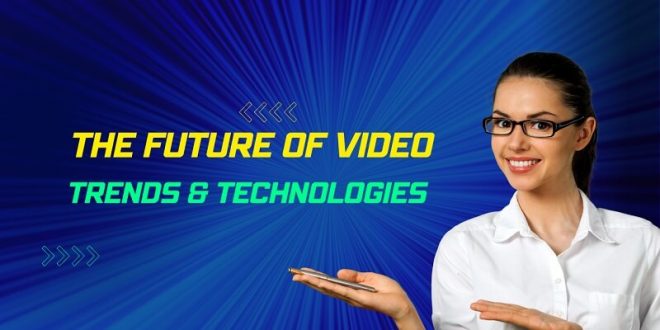Hello guys, today in this article, we are going to discuss the future of video: trends and technologies to watch. So keep reading.
With the rise of streaming services, the increasing popularity of user-generated content, and the rapid development of new video technologies; it’s no surprise that video has become an even more important part of our lives. Whether you’re a video content creator or marketer; it’s essential to stay up-to-date on the latest trends and technologies in order to stay ahead of the competition.
Let’s take a look at some of the most important trends and technologies that are shaping the future of branded video production.
How 5G Network Technology Will Impact Video
As we march forward into 2023 and beyond, new 5G network technologies are launching; changing the way we interact with each other online and offline. 5G, or fifth-generation mobile networks; come with multiple benefits for marketers who rely on video as a tool for communicating with their customers.
Not only can 5G provide faster connection speeds and data transfer rates than its predecessors, but it also enables higher quality streaming of videos; from 4K resolution to immersive virtual reality content. This means that marketers can create more dynamic campaigns that use video to reach new audiences in ways not previously possible.
Not only that, but 5G reduces latency, which was noticeable when streaming video over traditional internet speeds.
Augmented Reality and Virtual Reality in Video Production
These new technologies offer a unique way to make videos more captivating and interactive. With AR, viewers can experience enhanced visuals while watching the video; such as animated icons or characters that interact with their environment.
With VR, the virtual world completely immerses viewers and makes them part of the scene. This level of engagement helps brands tell stories more effectively and gives them an edge over competitors; as these formats aren’t as common yet.
Adaptive Streaming and Cloud Computing for a Better Video Experience
Adaptive streaming and cloud computing are two new video trends in the marketer’s toolkit that can be used to provide viewers with a better experience. Besides this, Adaptive streaming is a technology that uses algorithms to detect an individual’s network speed and selects video files of the appropriate quality for playback.
This ensures uninterrupted playback even if someone is connecting from a slower internet connection. Meanwhile, cloud computing enables users to store large files offsite and stream directly from remote servers; allowing them to access huge amounts of data without having to worry about hard drive space or download times.
Live Streaming Services
The days of watching pre-recorded videos on YouTube or Vimeo are over. Live streaming services like Twitch, YouTube Live, and Facebook Live have become increasingly popular in recent years; offering viewers access to real-time broadcasts with minimal delay.
This has opened up a wealth of possibilities for marketers looking to engage with their audience in new and exciting ways. From product launches to Q&A sessions with customers, live-streaming services can be used to build stronger relationships with your target audience.
Dynamic Ad Insertion to Boost Revenue
DAI offers increased precision when it comes to the advertising placement and can provide an incredible opportunity for marketers to boost revenue. It works by inserting ads into CTV (Connected TV) or OTT (Over-the-Top) content at the moment a viewer starts watching; enabling marketers to update their inventory in real-time.
Instead of cramming long ad breaks between sequences; viewers are served tailored and contextual ads right when they are viewing a piece of content. For advertisers, this technology provides exclusive access and greater control over their ad campaigns while improving overall view time and creativity opportunities.
AI and Machine Learning for Improved Video Quality
AI technology, such as automated and intelligent video editing, can be used to create videos that are much better quality than if they were created manually; saving time and money by eliminating the need for laborious manual edits.
Such tools have great applications for making videos look more professional; inserting personalized messages based on user interest and other automated activities. This can save a tremendous amount of effort. AI and machine learning don’t just make video easier to produce; though – they also help to speed up the process of promotion by providing insights into where audiences are spending their time online.
360-Degree Videos Taking Over the Scene
This interactive and visually engaging technology captures the attention of audiences; giving viewers the ability to experience a destination, product, or lifestyle before they step into it.
Due to its immersive capabilities, brands are leveraging 360-degree videos across multiple social media platforms as an effective marketing tool – allowing viewers to engage with their content in an entirely new way.
User Generated Content
User-generated content (UGC) has been growing in popularity in recent years due to its potential for driving engagement and brand loyalty. UGC involves having users create their own videos about your brand or products; which can then be shared on social media channels or featured on your website or blog. You can also opt for UGC-style videos; where you work with a professional content creator to produce a video that appears like it was organically created by a user.
By encouraging customers to share their stories through UGC campaigns; you can tap into an entirely new audience while also building stronger relationships with existing customers who participate in your campaigns.
The Growing Popularity of Live Streaming Platforms
Live streaming services are quickly becoming one of the hottest video trends; allowing individuals and businesses to quickly share their own events and happenings with a worldwide audience. Companies are utilizing the ‘live’ aspect of live streaming by hosting “virtual hangouts” or webinars where viewers can interact with the broadcaster in real-time.
It also serves as an effective tool for direct advertising campaigns; allowing customers to watch product demos or participate in contests while gaining exposure in real time.
Final Thoughts: Future of Video
The future of video is certainly an exciting one. Understanding the changes seen in the industry and predicting potential outcomes helps to ensure that your organization will be well prepared to leap on board with the next round of exciting developments.
There are even more amazing possibilities in store – and we will no doubt continue to see an increasingly vibrant world of content, broadcast quality, flexibility, and engagement along the way. Keep an eye out!
 free html design Free html design templates
free html design Free html design templates






